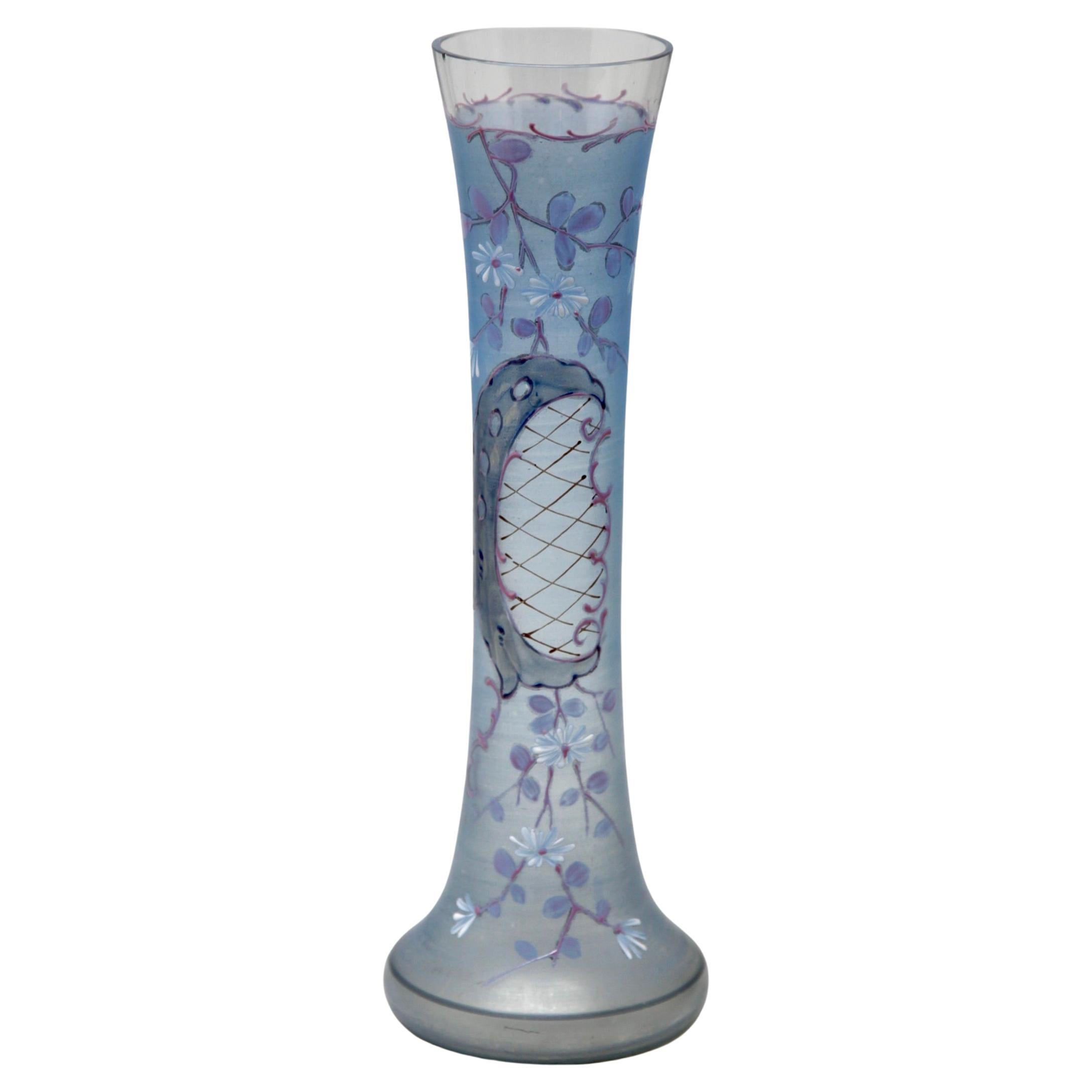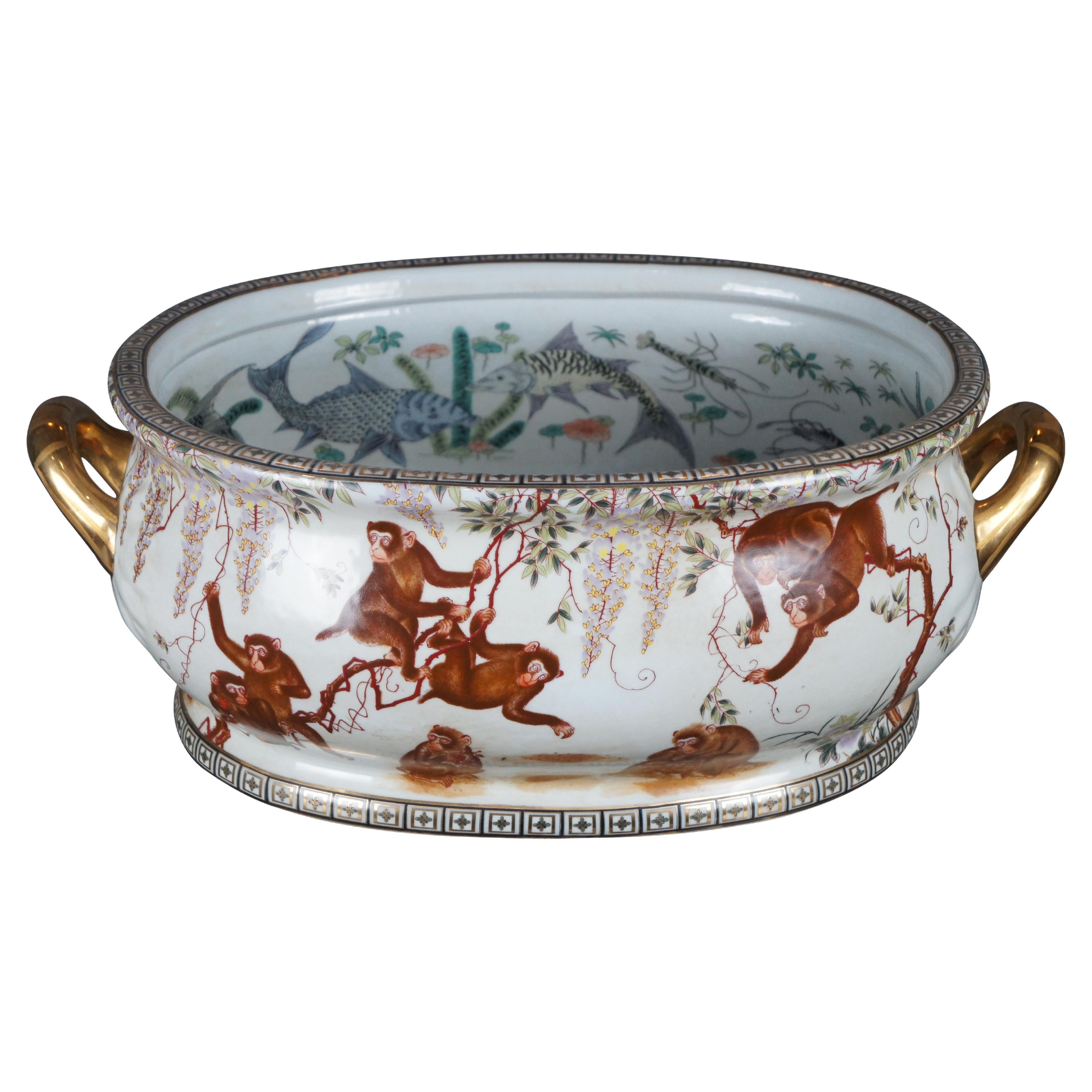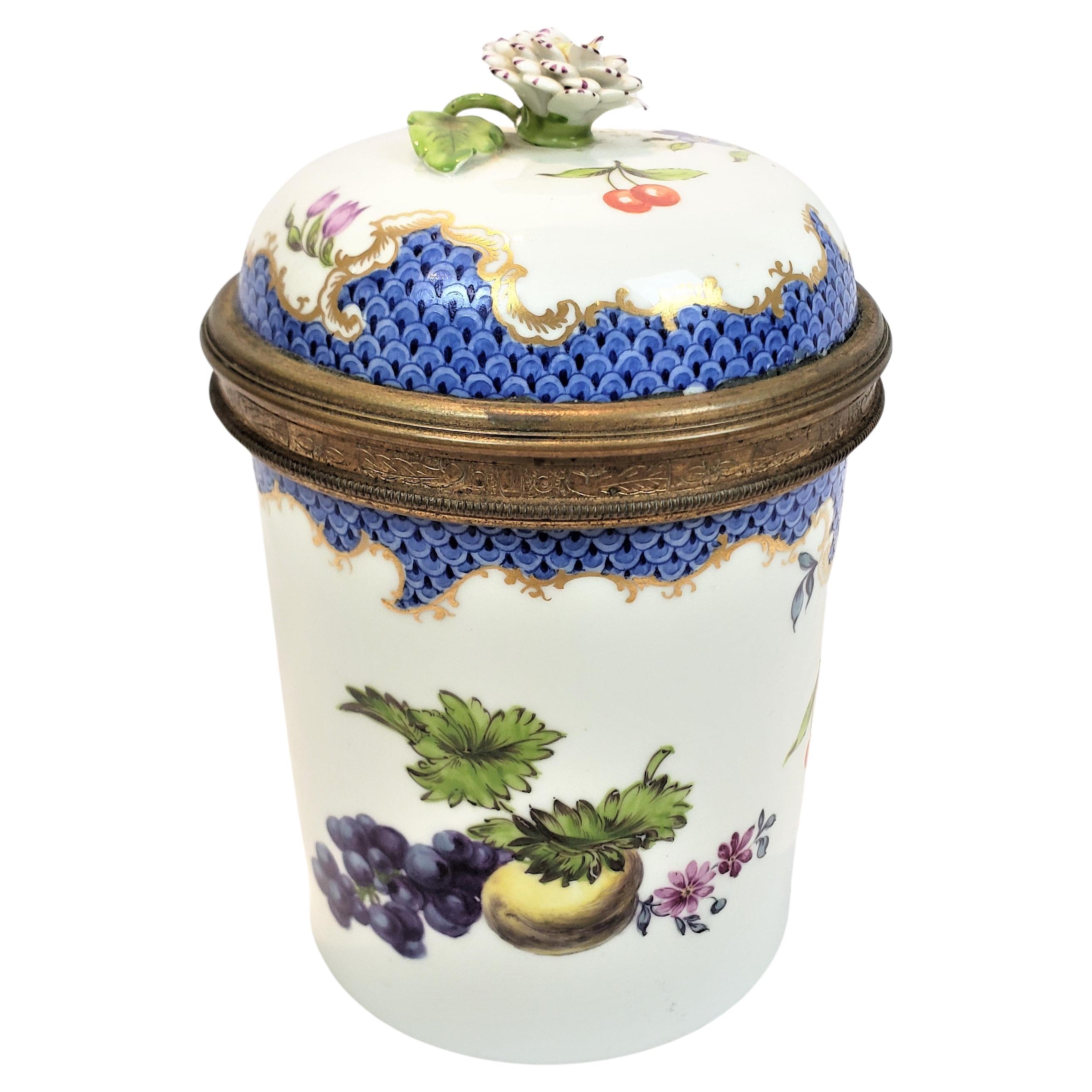Items Similar to Antique Chinoise Flower Pot, France, 1880s, Hand Painted Chinese Warrior
Want more images or videos?
Request additional images or videos from the seller
1 of 11
Antique Chinoise Flower Pot, France, 1880s, Hand Painted Chinese Warrior
About the Item
Exceptional hand-painted flower pot with a Chinese look, France 1880s.
Signed at the bottom by the artist "RLD".
In a special shade of green, we see a Chinese warrior in traditional dress followed by a girl in a pink kimono. On the other side of the flower pot is another warrior in matching clothing.
Large flower tendrils with blossoms round off the painting. A great artistic work of beautiful strong colors and elevations in the paint.
- Dimensions:Height: 6.7 in (17 cm)Diameter: 8.67 in (22 cm)
- Style:Chinoiserie (Of the Period)
- Materials and Techniques:
- Place of Origin:
- Period:
- Date of Manufacture:1880
- Condition:Very nice age-related condition.
- Seller Location:Greven, DE
- Reference Number:1stDibs: LU5419238110762
About the Seller
5.0
Platinum Seller
These expertly vetted sellers are 1stDibs' most experienced sellers and are rated highest by our customers.
Established in 2014
1stDibs seller since 2020
119 sales on 1stDibs
Typical response time: <1 hour
- ShippingRetrieving quote...Ships From: Münster, Germany
- Return PolicyA return for this item may be initiated within 14 days of delivery.
More From This SellerView All
- Antique 1880s Hand-Painted Flower Pot, FranceLocated in Greven, DEBeautifully crafted flower pot, France, 1880. With a curved and gilded edging on the top. The front shows a hand-painted country house with a pond in which two swans are swimming. Fl...Category
Antique 19th Century French Victorian Planters, Cachepots and Jardinières
MaterialsClay
- Antique Silvered Deer Sculpture, France, 1880sLocated in Greven, DEBeautiful antique silvered bronze work on a black stone base. Finely chiseled and natuarally depicted. France, circa 1880.Category
Antique Late 19th Century French Late Victorian Paperweights
MaterialsBronze
- Antique Gutta-Percha Picture Frame, Flowers, France, 1880s, 10 x 13 cmLocated in Greven, DEBeautiful victorian picture frame from France circa 1880. Made of the particular material Gutta-Percha.Category
Antique Late 19th Century French Late Victorian Picture Frames
MaterialsOther
- Antique Bassinoire, Warming Pan, Copper, France, 1880sLocated in Greven, DEBeautiful copper pan from France, a so-called Bassinoire. The lid can be opened with an external lever. This antique form of a todays hot-water bottle was primarily used in aristocr...Category
Antique 19th Century French Antiquities
MaterialsCopper
- Antique Boule Ball "G", Pétanque, 1880s, France, CraftsmanshipLocated in Greven, DEBeautiful, unique Boule ball, France, late 19th Century. In the 19th century, the manufacture of boules balls underwent significant development in France as the game of boules, particularly the pétanque variant, gained in popularity. The manufacture of boules balls during this period was a manual process that required expertise, precision and love to detail. In the late 19th and early 20th centuries, particularly in rural areas of France and other Mediterranean regions, olive wood was a commonly used source of material for making boules balls. This was not only due to the availability of the material, but also to the outstanding properties of olive wood, which was characterized by hardness, strength and a rich grain. First, the olive wood was carefully selected and shaped into raw balls, which were then sanded to the desired size and shape. The nails were then hammered into the balls one by one, making sure that they were evenly distributed and firmly anchored. Finally, the spheres were polished and coated with a protective varnish to enhance their natural beauty and protect them from the elements. The use of nails to decorate and reinforce olive wood boules was a traditional practice that not only gave the ball a rustic aesthetic, but also improved its durability and contributed to customization. Many balls were made according to the specific requirements and preferences of the players. Nails were driven at regular intervals around the ball, with each nail hole precisely placed so as not to affect the balance and weight distribution of the ball. These nails not only served as a decorative element, but also helped to strengthen the structure of the ball and make it more resistant to the hard knocks and wear and tear during play. Individual engravings or decorations were often applied to the balls to make them unique and identify the player. Antique boules...Category
Antique Late 19th Century French Late Victorian Antiquities
MaterialsMetal
- Antique Boule Ball "G", Pétanque, 1880s, France, CraftsmanshipLocated in Greven, DEBeautiful, unique Boule ball, France, late 19th Century. In the 19th century, the manufacture of boules balls underwent significant development in France as the game of boules, particularly the pétanque variant, gained in popularity. The manufacture of boules balls during this period was a manual process that required expertise, precision and love to detail. In the late 19th and early 20th centuries, particularly in rural areas of France and other Mediterranean regions, olive wood was a commonly used source of material for making boules balls. This was not only due to the availability of the material, but also to the outstanding properties of olive wood, which was characterized by hardness, strength and a rich grain. First, the olive wood was carefully selected and shaped into raw balls, which were then sanded to the desired size and shape. The nails were then hammered into the balls one by one, making sure that they were evenly distributed and firmly anchored. Finally, the spheres were polished and coated with a protective varnish to enhance their natural beauty and protect them from the elements. The use of nails to decorate and reinforce olive wood boules was a traditional practice that not only gave the ball a rustic aesthetic, but also improved its durability and contributed to customization. Many balls were made according to the specific requirements and preferences of the players. Nails were driven at regular intervals around the ball, with each nail hole precisely placed so as not to affect the balance and weight distribution of the ball. These nails not only served as a decorative element, but also helped to strengthen the structure of the ball and make it more resistant to the hard knocks and wear and tear during play. Individual engravings or decorations were often applied to the balls to make them unique and identify the player. Antique boules...Category
Antique Late 19th Century French Late Victorian Antiquities
MaterialsMetal
You May Also Like
- Rococo Handmade and Hand Painted Flower Spray Vase, France 1880sLocated in Verviers, BEwith rococo panel and hand-painted flower spray in the oriental style (c 1880) Handmade and hand-glazed in brilliant coloured Emameld flowers details. ...Category
Antique 1880s French Rococo Planters, Cachepots and Jardinières
MaterialsGlass
- Herend Chinese Bouquet Raspberry, Two Flower Pots in Hand-Painted PorcelainLocated in Copenhagen, DKHerend Chinese Bouquet Raspberry. Two flower pots in hand-painted porcelain modelled with handles. Mid-20th century. Measures: 17 x 1...Category
Mid-20th Century Hungarian Porcelain
MaterialsPorcelain
- 1880s French Bronze Classical UrnLocated in Tarrytown, NY1880s French bronze classical urn.Category
Antique 1880s Urns
MaterialsBronze
- Chinese Porcelain Hand Painted Monkey Fish Footbath Planter Jardinière Cache PotLocated in Dayton, OHBeautiful vintage Chinese foot bath with climbing monkeys and innet fish motif, circa last quarter 20th century. Made from porcelain with a polychrome finish and gold plated handles....Category
Late 20th Century Chinoiserie Planters, Cachepots and Jardinières
MaterialsPorcelain
- Antique Meissen Covered Pot or Jar with Flower Handle & Hand-Painted FruitsBy Meissen PorcelainLocated in Hamilton, OntarioThis antique covered jar or pot was made by the well known Meissen factory of Germany in approximately 1750 in the period Louis XV style. This lidd...Category
Antique Late 18th Century German Louis XV Jars
MaterialsBronze
- Vintage Chinese Satsuma Style Hand Painted Quail Bird Flower Porcelain VaseLocated in Philadelphia, PAVintage Chinese Satsuma Style Hand Painted Quail Bird and Flower Porcelain Vase. Circa Late 20th Century. Measurements: 24.5" H x 10" Diameter.Category
Late 20th Century Chinoiserie Vases
MaterialsPorcelain
Recently Viewed
View AllMore Ways To Browse
Jardiniere In Ceramic
Antique Shell Planter
Terracotta Large Vase Planter
Fishbowl Vase
Antique Imari Jardiniere
Dragon Fish Bowl
Italian Mid Century Chinoiserie Cachepot Porcelain
Japanese Porcelain Sake Barrel
Peanut John Follis
Rose Medallion Planter Bowl
Tall Vintage Terracotta Vessel From Mexico
Tobacco Leaf Cachepot
Trinum Planter
Vintage Pair Of Handpainted Ceramic Urn Vase
Wedgewood Crimson Jardiniere
Blue Pottery Planter
Blue And White Chinese Jardiniere
Sevres Planter





